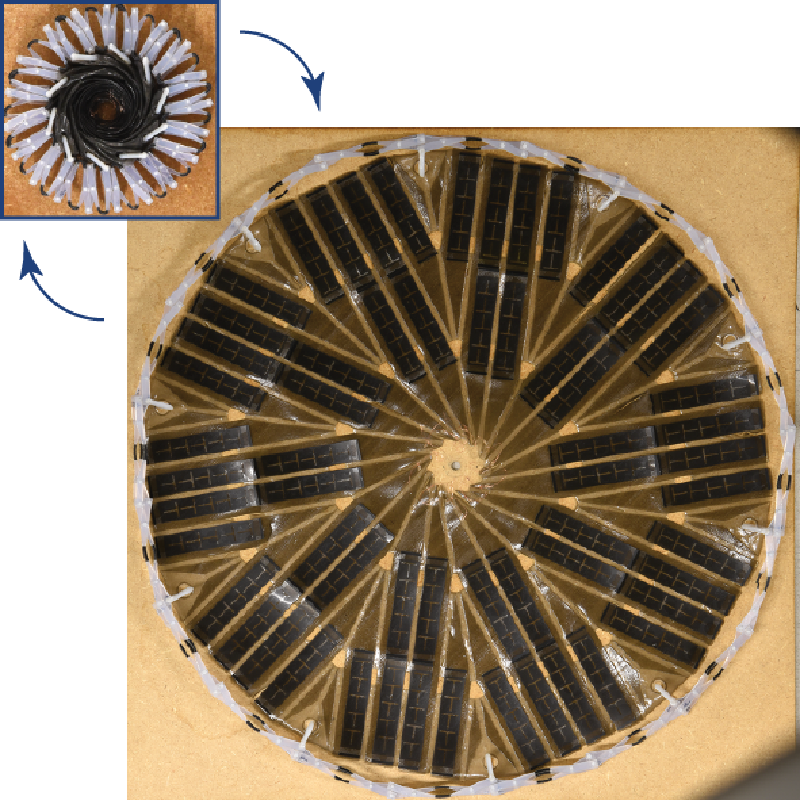Folded Solar Panel Opens Without Power Source
A toy has inspired a new design for a solar cell that could be folded away compactly on a spacecraft and then rapidly expanded when needed. The structure can unfold to increase its surface area by ten times in just 40 seconds without any power source; instead, it uses a polymer that moves in response to temperature changes. The concept could also be used in other situations where sheet-like structures undergo dramatic and rapid changes in shape, such as tents or roofing canopies.
Sheets and membranes that unfurl from compact shapes folded in an origami-like manner, called deployable structures, have a variety of potential applications in architecture, energy generation, and robotics. They are found in nature—for example, in stowed insect wings and in leaves packed inside buds. Artificial deployable structures are typically made from thin, flexible sheets, and the unpacking can be effected by a mechanical framework that pulls the folded sheet open.
Mechanical engineers Kristina Shea of the Swiss Federal Institute of Technology (ETH) in Zürich and Chiara Daraio of the California Institute of Technology in Pasadena and their colleagues wanted to develop a deployable structure that would open quickly and without external power. Shea and team member Tian Chen, an ETH graduate student, had previously built mechanical structures that change shape in response to temperature by incorporating a so-called shape-memory polymer [1]. Below a certain transition temperature, the material is stiff, so you can bend it when warm and then “lock in” a specific structure by cooling. At higher temperatures the material becomes soft and will return to its initial state. Other researchers have used these materials to make sheets that self-fold into boxes, pyramids, and other shapes in response to temperature changes [2].
The device the team created has a rigid framework made from hinged joints. The joints employ a mechanism devised by engineer Chuck Hoberman for use in shape-changing architecture. The design is similar to the so-called Hoberman sphere, sold as a toy that forms a compact ball shape when closed but which opens into a much larger spherical shell.
However, the new structure uses a circular rather than spherical frame, which holds a disk-shaped sheet. The sheet is folded following the same principle as the so-called “flasher” origami fold (used by one team member in the past [3]), in which parallel creases allow it to collapse into a compact spiral somewhat reminiscent of the petal pattern of a rose. The researchers were able to achieve an efficiently packed and quickly unfolding structure by computationally optimizing the folding pattern to best fit within the framework of 20 Hoberman hinges.
The team made both the hinge units and the thin sheet from a shape-memory polymer. They folded the sheet and its hinged frame into the compact state at 40∘C (above the transition temperature of 35∘C) and then locked it by cooling to room temperature. Warming the structure in 40∘C water opened it up again. The fully open, 79-cm-diameter sheet came from an initially compact object measuring just 25 cm across: about a tenfold increase in surface area. The unfolding took just 40 seconds. In a solar-cell application, the shape-memory polymer sheet could be coated with a photovoltaic material, although it is conceivable that shape-memory materials might be devised with photovoltaic properties, says Shea.
For use in space, the unfolding transition could be triggered simply by warming due to absorption of solar radiation, says Shea, provided that one uses shape-memory polymers that switch at the temperatures relevant in space. The collapsed system could be kept below its transition temperature until positioned outside of the spacecraft, when warming by solar radiation would expand it, she says.
Shea says that there could be many other applications of autonomous deployable structures like this, for example, “a structure deployed in a harsh or remote environment or a mirror in a telescope array.” On smaller scales, she says, active materials combined with origami mechanics could be used for targeted drug delivery within the human body.
“This research could open up new avenues in energy harvesting in aerospace engineering, where lightweight devices are vital to minimize the weight,” says engineer Massimiliano Gei of Cardiff University in the UK. Francisco Lopez Jimenez, who works on deployable structures for space at the University of Colorado in Boulder, agrees that, by removing external power sources, such designs “will likely reduce the mass, as well as the probability of an element failing during deployment.”
This research is published in Physical Review Applied.
–Philip Ball
Philip Ball is a freelance science writer in London. His latest book is How Life Works (Picador, 2024).
References
- T. Chen and K. Shea, “An autonomous programmable actuator and shape reconfigurable structures using bistability and shape memory polymers,” 3D Print. Addit. Manuf. 5, 91 (2018).
- Qi Ge, C. K. Dunn, H Jerry Qi, and Martin L Dunn, “Active origami by 4D printing,” Smart Mater. Struct. 23, 094007 (2014).
- R. J. Lang, S. Magleby, and L. Howell, “Single degree-of-freedom rigidly foldable cut origami flashers,” J. Mechanisms Robotics 8, 031005 (2016).





